Why the Inverted Yield Curve Hasn’t Led to a Recession in this Cycle
Over the past 70+ years, nearly every U.S. recession has been preceded by an inverted yield curve. Historically, any time the yield curve inverted for a period of at least two months, a recession followed within the next 18 months.1
The chart below makes this relationship clear – the red circles indicate yield curve inversions, and the gray bars show the recessions that followed. Readers can see how closely the two have correlated historically.
Recessions Historically Follow Yield Curve Inversions

The current cycle, however, appears to be playing out differently.
The yield curve – as measured by the difference between the yield on the 10-year U.S. Treasury bond and the 3-month U.S. Treasury bond – first inverted in October 2022, and since then the U.S. economy has not only continued expanding but also accelerated in some periods.
Before digging into this disconnect, it’s important to understand the yield curve in terms of its impact on credit—which is the fuel that keeps the economy humming.
When the yield curve is upward sloping, it means short-term borrowing rates are lower than long-term lending rates for banks, which creates positive net interest margins and makes it profitable to lend. When the yield curve is inverted, however, the opposite is true – banks have to borrow at high short-term rates, which creates profitability issues with lending and tighter credit conditions for the economy. When credit and lending activity dries up, economic activity tends to follow.
In the current cycle, however, higher short-term rates have not had a major impact on bank profitability or lending activity over the past year. The reason: banks are still flush with deposits.
Deposits at Commercial Banks Surged After the Pandemic and Remain at High Levels

In a sense, the Fed’s aggressive rate hike campaign did not put banks in the unwelcome position of having to borrow at increasingly higher short-term rates. Banks had – and continue to have – plenty of cash on hand. To be fair, deposit rates have started going up at banks recently, and increased competition for deposits could become an impediment to bank profitability. But in my view, the Fed is likely to start cutting rates before that becomes a concern.
In the meantime, credit has been flowing in the U.S. economy. Recent declines in long-duration Treasury yields have led to a surge in investment-grade corporate bond issuance, which is running at a record pace so far in 2024. And despite worries that last year’s regional bank stress would cut off major sources of lending, banks have been loosening lending standards in recent months. In the chart below, the percentage of banks tightening lending standards for mid-size and large business commercial loans (blue line), loans to small firms (red line), and auto loans to consumers (green line) have all fallen.
The Net Percentage of Banks Tightening Lending Standards Has Fallen Recently

Bottom Line for Investors
Consumers have already taken falling, long-duration interest rates as a prompt to increase their borrowing. Mortgage applications are up, and we’ve seen much higher issuance of asset-backed securities – which are bonds backed by debt like credit cards and auto loans – rising materially in 2024.
The yield curve inversion will eventually unwind, but the key question looking forward will be how that happens. The Fed could start cutting rates later this year to bring the short end of the curve lower over time, while the economy continues to expand. This would in turn give banks additional options for lending, and we could see even more meaningful increases to credit flowing in the economy – a harbinger for more growth ahead.
Disclosure
2 Fred Economic Data. February 26, 2024. https://fred.stlouisfed.org/series/T10Y3M#
3 Fred Economic Data. February 23, 2024. https://fred.stlouisfed.org/series/DPSACBW027SBOG#
4 Fred Economic Data. February 5, 2024. https://fred.stlouisfed.org/series/DRTSCILM#
DISCLOSURE
Past performance is no guarantee of future results. Inherent in any investment is the potential for loss.
Zacks Investment Management, Inc. is a wholly-owned subsidiary of Zacks Investment Research. Zacks Investment Management is an independent Registered Investment Advisory firm and acts as an investment manager for individuals and institutions. Zacks Investment Research is a provider of earnings data and other financial data to institutions and to individuals.
This material is being provided for informational purposes only and nothing herein constitutes investment, legal, accounting or tax advice, or a recommendation to buy, sell or hold a security. Do not act or rely upon the information and advice given in this publication without seeking the services of competent and professional legal, tax, or accounting counsel. Publication and distribution of this article is not intended to create, and the information contained herein does not constitute, an attorney-client relationship. No recommendation or advice is being given as to whether any investment or strategy is suitable for a particular investor. It should not be assumed that any investments in securities, companies, sectors or markets identified and described were or will be profitable. All information is current as of the date of herein and is subject to change without notice. Any views or opinions expressed may not reflect those of the firm as a whole.
Any projections, targets, or estimates in this report are forward looking statements and are based on the firm’s research, analysis, and assumptions. Due to rapidly changing market conditions and the complexity of investment decisions, supplemental information and other sources may be required to make informed investment decisions based on your individual investment objectives and suitability specifications. All expressions of opinions are subject to change without notice. Clients should seek financial advice regarding the appropriateness of investing in any security or investment strategy discussed in this presentation.
Certain economic and market information contained herein has been obtained from published sources prepared by other parties. Zacks Investment Management does not assume any responsibility for the accuracy or completeness of such information. Further, no third party has assumed responsibility for independently verifying the information contained herein and accordingly no such persons make any representations with respect to the accuracy, completeness or reasonableness of the information provided herein. Unless otherwise indicated, market analysis and conclusions are based upon opinions or assumptions that Zacks Investment Management considers to be reasonable. Any investment inherently involves a high degree of risk, beyond any specific risks discussed herein.
The S&P 500 Index is a well-known, unmanaged index of the prices of 500 large-company common stocks, mainly blue-chip stocks, selected by Standard & Poor’s. The S&P 500 Index assumes reinvestment of dividends but does not reflect advisory fees. The volatility of the benchmark may be materially different from the individual performance obtained by a specific investor. An investor cannot invest directly in an index.
The Russell 1000 Growth Index is a well-known, unmanaged index of the prices of 1000 large-company growth common stocks selected by Russell. The Russell 1000 Growth Index assumes reinvestment of dividends but does not reflect advisory fees. An investor cannot invest directly in an index. The volatility of the benchmark may be materially different from the individual performance obtained by a specific investor.
Nasdaq Composite Index is the market capitalization-weighted index of over 3,300 common equities listed on the Nasdaq stock exchange. The types of securities in the index include American depositary receipts, common stocks, real estate investment trusts (REITs) and tracking stocks, as well as limited partnership interests. The index includes all Nasdaq-listed stocks that are not derivatives, preferred shares, funds, exchange-traded funds (ETFs) or debenture securities. An investor cannot invest directly in an index. The volatility of the benchmark may be materially different from the individual performance obtained by a specific investor.
The Dow Jones Industrial Average measures the daily stock market movements of 30 U.S. publicly-traded companies listed on the NASDAQ or the New York Stock Exchange (NYSE). The 30 publicly-owned companies are considered leaders in the United States economy. An investor cannot directly invest in an index. The volatility of the benchmark may be materially different from the individual performance obtained by a specific investor.
The Bloomberg Global Aggregate Index is a flagship measure of global investment grade debt from twenty-four local currency markets. This multi-currency benchmark includes treasury, government-related, corporate and securitized fixed-rate bonds from both developed and emerging markets issuers. An investor cannot invest directly in an index. The volatility of the benchmark may be materially different from the individual performance obtained by a specific investor.
The ICE Exchange-Listed Fixed & Adjustable Rate Preferred Securities Index is a modified market capitalization weighted index composed of preferred stock and securities that are functionally equivalent to preferred stock including, but not limited to, depositary preferred securities, perpetual subordinated debt and certain securities issued by banks and other financial institutions that are eligible for capital treatment with respect to such instruments akin to that received for issuance of straight preferred stock. An investor cannot invest directly in an index. The volatility of the benchmark may be materially different from the individual performance obtained by a specific investor.
The MSCI ACWI ex U.S. Index captures large and mid-cap representation across 22 of 23 Developed Markets (DM) countries (excluding the United States) and 24 Emerging Markets (EM) countries. The index covers approximately 85% of the global equity opportunity set outside the U.S. An investor cannot invest directly in an index. The volatility of the benchmark may be materially different from the individual performance obtained by a specific investor.
The Russell 2000 Index is a well-known, unmanaged index of the prices of 2000 small-cap company common stocks, selected by Russell. The Russell 2000 Index assumes reinvestment of dividends but does not reflect advisory fees. An investor cannot invest directly in an index. The volatility of the benchmark may be materially different from the individual performance obtained by a specific investor.
The S&P Mid Cap 400 provides investors with a benchmark for mid-sized companies. The index, which is distinct from the large-cap S&P 500, is designed to measure the performance of 400 mid-sized companies, reflecting the distinctive risk and return characteristics of this market segment.
The S&P 500 Pure Value index is a style-concentrated index designed to track the performance of stocks that exhibit the strongest value characteristics by using a style-attractiveness-weighting scheme. An investor cannot directly invest in an index. The volatility of the benchmark may be materially different from the individual performance obtained by a specific investor.